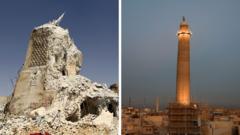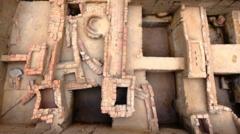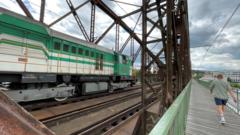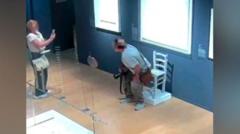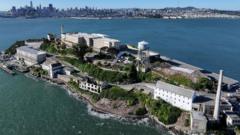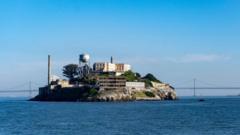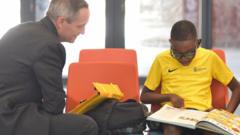Historic landmarks in Mosul, Iraq, are experiencing a renaissance as the city emerges from the shadows of destruction wrought by the extremist Islamic State (IS) group. Following IS's occupation from 2014 to 2017, a dedicated restoration initiative, spearheaded by Unesco, has painstakingly reopened churches, mosques, and other significant sites, marking a poignant return to the city's historical roots.
On Wednesday, Unesco's director-general Audrey Azoulay attended a ceremonial event celebrating these restorations alongside local artisans, residents, and diverse religious representatives. Mosul, long regarded as a beacon of multicultural harmony, suffered grievous losses under IS's extremist regime, including the destruction of the iconic leaning al-Hadba minaret, a symbol of the city's skyline.
In the wake of IS's retreat, the city was left in ruins, with vast swathes of the Old City—80%—laid to waste. Photographer Ali al-Baroodi recalls the harrowing aftermath, describing Mosul as a "ghost town," tarnished by the remnants of war. The al-Hadba minaret, once a proud fixture, lay inappreciable disarray, representing a deep fracture in the community's spirit.
Unesco allocated $115 million for the extensive restoration effort, primarily funded by contributions from the United Arab Emirates and the European Union. The initiative sought not only to restore physical structures but also to rebuild the trust among Mosul's diverse religious communities, which were often pitted against each other during the occupation.
Father Olivier Poquillon, who returned to oversee the restoration of the al-Saa'a Convent, emphasized that rebuilding trust was as crucial as reconstructing walls. Working hand-in-hand with community members from varied backgrounds, the restoration process has emerged as a collaborative effort, uniting individuals across sectarian lines.
Leading the architectural vision for these restorations is chief architect Maria Rita Acetoso, who brings experience from similar projects across war-torn regions. She highlights the role of cultural heritage restoration in empowering local communities and fostering meaningful job creation; thus far, over 1,300 young locals have been trained in traditional skills.
The unmistakable sounds of church bells ringing from the al-Tahera Church signal a renewed heartbeat in Mosul. With historical structures like the al-Hadba minaret and al-Nuri mosque also undergoing transformative restoration, former residents are rekindling their familial connections to the city, as seen in the cases of locals such as Mustafa and Abdullah, who have returned to their ancestral homes.
While the scars of the past still linger, the revitalization of Mosul's Old City symbolizes a revitalized spirit of hope. Ali al-Baroodi poignantly describes witnessing this revival as akin to a "dead person coming back to life," reflecting the resilient essence that defines Mosul's enduring legacy amidst its trials.
On Wednesday, Unesco's director-general Audrey Azoulay attended a ceremonial event celebrating these restorations alongside local artisans, residents, and diverse religious representatives. Mosul, long regarded as a beacon of multicultural harmony, suffered grievous losses under IS's extremist regime, including the destruction of the iconic leaning al-Hadba minaret, a symbol of the city's skyline.
In the wake of IS's retreat, the city was left in ruins, with vast swathes of the Old City—80%—laid to waste. Photographer Ali al-Baroodi recalls the harrowing aftermath, describing Mosul as a "ghost town," tarnished by the remnants of war. The al-Hadba minaret, once a proud fixture, lay inappreciable disarray, representing a deep fracture in the community's spirit.
Unesco allocated $115 million for the extensive restoration effort, primarily funded by contributions from the United Arab Emirates and the European Union. The initiative sought not only to restore physical structures but also to rebuild the trust among Mosul's diverse religious communities, which were often pitted against each other during the occupation.
Father Olivier Poquillon, who returned to oversee the restoration of the al-Saa'a Convent, emphasized that rebuilding trust was as crucial as reconstructing walls. Working hand-in-hand with community members from varied backgrounds, the restoration process has emerged as a collaborative effort, uniting individuals across sectarian lines.
Leading the architectural vision for these restorations is chief architect Maria Rita Acetoso, who brings experience from similar projects across war-torn regions. She highlights the role of cultural heritage restoration in empowering local communities and fostering meaningful job creation; thus far, over 1,300 young locals have been trained in traditional skills.
The unmistakable sounds of church bells ringing from the al-Tahera Church signal a renewed heartbeat in Mosul. With historical structures like the al-Hadba minaret and al-Nuri mosque also undergoing transformative restoration, former residents are rekindling their familial connections to the city, as seen in the cases of locals such as Mustafa and Abdullah, who have returned to their ancestral homes.
While the scars of the past still linger, the revitalization of Mosul's Old City symbolizes a revitalized spirit of hope. Ali al-Baroodi poignantly describes witnessing this revival as akin to a "dead person coming back to life," reflecting the resilient essence that defines Mosul's enduring legacy amidst its trials.

